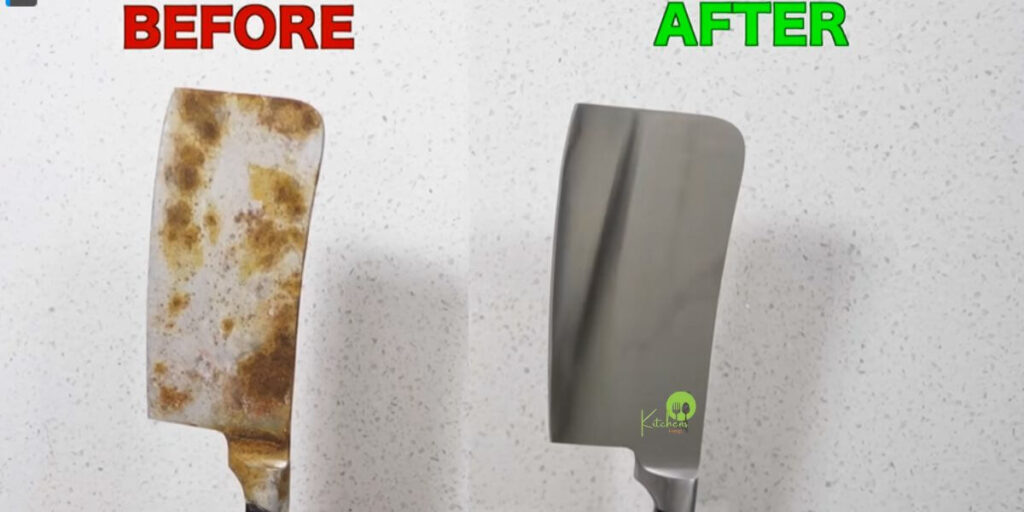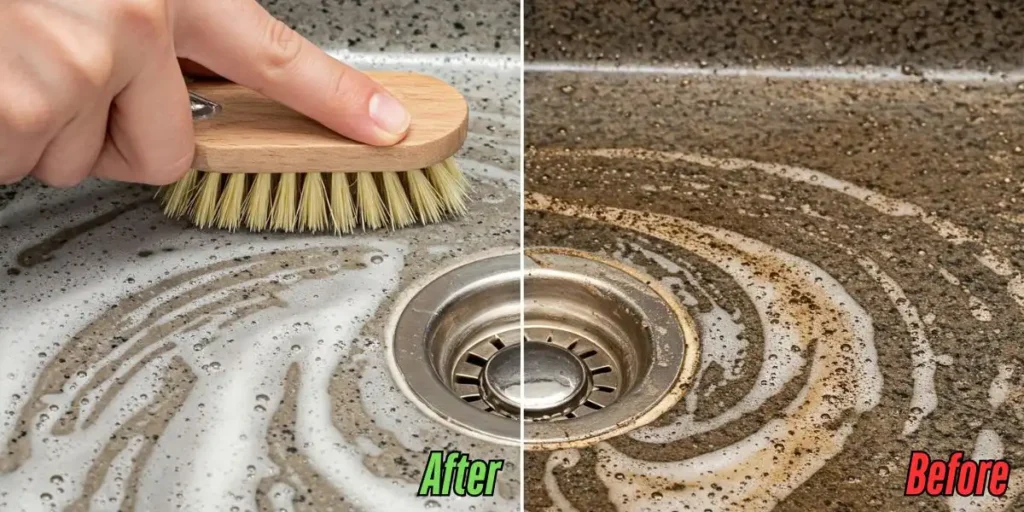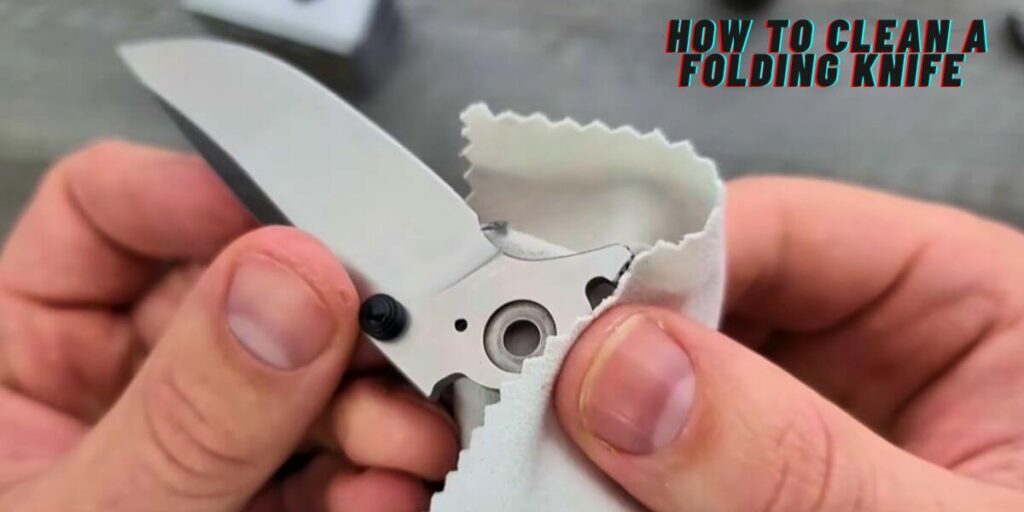How to Clean Rust off of a Knife: Tips for Long-Lasting Blade Care
How to clean rust off a knife is crucial for anyone who cherishes their cutlery and wants to maintain it in top condition. Regular maintenance, including proper cleaning and drying techniques, can prevent rust from forming in the first place, ensuring that your knives remain as practical and beautiful as the day you bought them. With the proper care, your knives can serve you well for years to come, enhancing every slicing, dicing, and chopping experience.

Understanding Rust Formation
Rust is a common enemy for knives, especially those made from carbon steel, which is known for its sharpness and edge retention but is also more susceptible to corrosion. clean rust off of a Knife forms when iron reacts with water and oxygen, producing iron oxide, which can occur even in small amounts of moisture. This chemical reaction is particularly prevalent in humid environments, where the air is moist or knives are left wet after washing or use.
There are different types of rust
Surface rust is the least severe and often appears as a reddish-brown discoloration. Surface rust can typically be removed with simple methods such as using steel wool or a rust eraser, making it relatively easy to maintain your knives.
Deeper corrosion, which penetrates the metal more significantly, can cause substantial damage to the blade and may require more intensive care, including professional restoration or even replacement.
Proper storage is crucial to prevent these issues and keep your knives pristine. Storing knives in a dry place using a knife block or magnetic strip can help minimize exposure to moisture.
Regular maintenance, such as drying knives thoroughly after washing and applying a light coat of mineral oil, can also help combat rust and prolong the life of your stainless steel knives. These preventative measures ensure your knives remain sharp and functional for all your culinary endeavors.
When Should You Clean Rust Off a Knife?
Recognizing when a clean rust off of a Knife is crucial for maintaining its performance and longevity. Light surface rust is often visible as small, reddish-brown spots on the blade, which can be caused by exposure to moisture or acidic substances.
This type of rust feels slightly rough to the touch but typically does not penetrate deeply into the metal, allowing for relatively easy removal with proper cleaning techniques. On the other hand, severe corrosion manifests through pitting or deep, rough patches that can compromise the knife’s structure, potentially affecting its cutting ability and safety during use.

It’s essential to clean your knives promptly when you notice any rust, as addressing the issue early can prevent more extensive damage. If the corrosion is extensive or has caused significant deterioration, professional restoration services might be required to restore the knife to its original condition.
Furthermore, regularly inspecting your kitchen knives at least once a month ensures they remain safe and effective for all your culinary endeavors. By monitoring your knives and taking proactive measures, you can enjoy their optimal performance and extend their lifespan significantly.
Materials Needed to Clean Rust Off a Knife
You don’t need specialized products to effectively remove rust from your knives. Thanks to their natural acidic properties, everyday household items such as baking soda, vinegar, and lemon juice can work wonders.
For instance, a paste made from baking soda and water can gently scrub away rust without scratching the metal surface. If you prefer using tools for more stubborn rust, consider reaching for sandpaper, a wire brush, or steel wool, which can provide more aggressive cleaning. Just be cautious when using these tools to avoid damaging your knives.
Always prioritize safety by wearing gloves and eye protection while using rust removal methods. It’s crucial to protect your skin and eyes from any potential irritants. Also, remember that chemicals or abrasive tools can be harmful if not used correctly, so follow any instructions and ensure good ventilation in your workspace. By taking these precautions, you can effectively restore your knives while keeping yourself safe.
Step-by-Step Guide to Removing Surface Rust
Baking Soda Paste
Baking soda is a gentle yet effective way to clean rust off a Knife. Mix it with water to form a thick paste. Apply the paste to the rust spots on your pocket knife or kitchen knife, then scrub gently with a cloth or toothbrush. Rinse the blade thoroughly afterward, ensuring no residue remains.
Vinegar Soak
Vinegar is acidic and excellent for loosening rust stains. Submerge the rusty parts of the knife in white vinegar for a few hours. After soaking, wipe the blade clean with a soft cloth. This method works well for stainless steel knives, as it won’t harm the material.
Lemon Juice and Salt
This natural cleaning method combines lemon juice’s acidity with salt’s abrasiveness. Sprinkle salt over the rust spots and squeeze lemon juice on top. Allow it to sit for a few hours, then scrub gently to remove the rust.
Commercial Rust Removers
If home remedies aren’t sufficient, consider using a commercial rust remover. Products designed for cutlery are generally safe for use on knife blades. Follow the manufacturer’s instructions and take precautions to protect yourself and the knife.
Dealing with Heavier Rust (Pitting or Deep Corrosion)
When rust penetrates the metal deeper, you must employ more brutal methods to restore the item. First, assess the severity of the rust by closely examining both the texture and color; lighter rust is usually easier to manage than more profound, more extensive corrosion.

To address deep rust, it’s best to use abrasive tools such as sandpaper or a wire brush, which can effectively strip away the rust without harming the underlying metal. Start with a coarser grit to remove the bulk of the rust, then progress to finer grits for a smoother finish.
Always proceed with caution during this process, as it’s crucial to avoid removing too much metal, which can inadvertently damage the knife and affect its functionality. Taking your time and being gentle will yield the best results and preserve the integrity of your tools.
After removal, thoroughly dry the knife, then apply a rust inhibitor, such as mineral or cooking oil. This step helps prevent future rust from developing on your knives. Remember to store your knives in a cool, dry place after use to minimize exposure to moisture.
Polishing and Restoring the Knife’s Finish
Once Clean Rust off of a Knife is complete, polishing the blade becomes a crucial step that not only restores its shine but also plays an essential role in preventing future rusting. Selecting a high-quality polishing compound specifically designed for metal surfaces is necessary to achieve an optimal finish.
Using a soft cloth or a buffing wheel, gently buff the blade, ensuring you cover all areas evenly and paying attention to any intricate designs or patterns on the blade. This meticulous process enhances the blade’s aesthetic appeal, giving it a polished, mirror-like finish. It also smooths its surface, improving cutting performance and precision.
After the polishing
Applying a thin layer of oil is vital. You can opt for mineral oil, ideal for kitchen knives, or a food-safe oil if you’re concerned about direct contact with food. This oil creates a protective barrier against moisture, effectively reducing the risk of rust formation. It also helps maintain the blade’s luster and functionality over time.
This simple yet effective maintenance step is essential for preserving the knife’s appearance and performance, ensuring it remains a reliable tool in your kitchen or workshop. Regular maintenance like this can significantly extend the life of your knife, allowing it to serve you well for years to come while keeping it looking as good as new. By caring for your knife, you invest in its longevity and enhance your overall culinary experience.
Preventing Future Rust Build-Up
Prevention is critical to maintaining rust-free knives, which are essential tools in any kitchen. These knives not only facilitate efficient food preparation but also enhance the overall cooking experience. Always store your knives in a dry environment to achieve rust-free blades, as moisture can lead to rust formation, compromising their appearance and functionality.
After using your knives, it is crucial to avoid leaving them wet, as lingering moisture can cause significant damage over time. Instead, promptly wash them with warm, soapy water and dry them thoroughly with a soft cloth to ensure all water is removed. This simple practice helps maintain the integrity of the blade and the handle.
In Addition to regular washing
Consider incorporating a routine of oiling the blade with food-safe mineral oil. This protects the knife against moisture and enhances its longevity and performance. The oil helps to prevent rust while keeping the blade smooth and sharp, allowing for effortless slicing and dicing.
Furthermore, utilizing products like silicone wraps or knife sheaths can provide extra protection during storage. These accessories prevent scratches and exposure to humidity, ensuring your knives remain pristine. Adopting a consistent maintenance routine that includes proper washing, drying, oiling, and storing will ensure your cutlery remains in excellent condition.
This allows you to enjoy your cooking experience without worrying about rust or deterioration, ultimately making your time in the kitchen more enjoyable and efficient. Regular care not only prolongs the life of your knives but also enhances your culinary skills, allowing you to create delicious meals confidently.
Safety Considerations
Rusty knives can pose significant hazards if not handled properly, making it essential to approach the task cautiously. Rust affects the blade’s appearance and can compromise its integrity, leading to potential injuries during use.
Handling rusty knives carefully is crucial to avoid cutting yourself or causing further damage to the knife. Always ensure the blade is pointed away from your hands while cleaning to minimize the risk of accidental cuts, as a slip can easily lead to severe injury.
In addition to careful handling, wearing protective gloves is essential to safeguard against cuts and prevent exposure to harsh chemicals used in the cleaning process. Many rust removal products contain strong solvents that can irritate the skin, so gloves provide an essential layer of protection.

When working with rust removers, make sure to do so in a well-ventilated area to avoid inhaling harmful fumes. Proper ventilation is critical, as some of these products can release volatile organic compounds (VOCs) that are hazardous to your health. Taking these precautions will help ensure a safer and more effective cleaning experience.
By following these guidelines, you can restore your knives to their optimal condition, enhancing their functionality and lifespan. A well-maintained knife can significantly impact your cooking experience, allowing for smoother and safer food preparation.
Common Mistakes to Avoid When Cleaning Rust Off a Knife
Avoid over-scrubbing your knife, damaging the blade’s edge, and significantly affecting its cutting performance. Scrubbing too hard risks dulling the blade, making slicing and chopping tasks more complex and less efficient. Additionally, harsh chemicals in many cleaning products can strip away the protective coatings designed to keep your knife in optimal condition. This compromises the knife’s performance and makes it more vulnerable to future rust and corrosion, which can shorten its lifespan.
After cleaning, it’s essential to dry the knife thoroughly with a soft cloth. Leaving moisture on the surface can promote the formation of new rust spots, which are not only unsightly but can also lead to further deterioration. To extend the life of your knife, consider storing it in a dry environment and regularly checking for any signs of wear or damage. These extra steps will help maintain your knife’s longevity and effectiveness in the kitchen, ensuring you enjoy precision and ease while preparing your favorite meals.
Frequently Asked Questions (FAQ)
Rust forms when iron in the knife reacts with water and oxygen. Humidity and improper storage can accelerate this process.
Yes, rust can dull the blade and weaken its structure, impacting cutting efficiency and safety.
Stainless steel knives are more rust-resistant than carbon steel knives but require proper care to prevent rusting.
Conclusion
Rust removal is essential for anyone who values their knives and wants to keep them in top condition. Rust can affect the appearance of your blades and compromise their functionality. Following these detailed steps, you can effectively clean rust off your knives and restore them to their former glory.
Start by assessing the extent of the rust damage; light rust can often be removed with a simple mixture of baking soda and water, while more severe corrosion may require specialized rust removers or sanding. Use a soft cloth or sponge to avoid scratching the blade’s surface. After removing the rust, it’s crucial to thoroughly clean and dry your knives to prevent any moisture from causing further rusting.
Regular maintenance is critical in addition to rust removal. This includes honing your blades to keep them sharp and using mineral oil to protect them from moisture. Proper storage is also vital; consider using magnetic strips or knife blocks to keep your knives protected and away from humidity. By incorporating these practices, you’ll prolong the life of your knives, ensuring they remain reliable tools for your culinary adventures or outdoor excursions.
Related Posts
-
 30 Nov 2024 CleaningBest Ways to Clean Granite Composite Kitchen Sinks at Home
30 Nov 2024 CleaningBest Ways to Clean Granite Composite Kitchen Sinks at Home -
 26 Nov 2024 CleaningHow to Clean Stainless Steel Countertops | Experts Tips
26 Nov 2024 CleaningHow to Clean Stainless Steel Countertops | Experts Tips -
 17 Nov 2024 Cleaning5 Tricks | How to Clean Shower Head Without Vinegar
17 Nov 2024 Cleaning5 Tricks | How to Clean Shower Head Without Vinegar -
 14 Nov 2024 CleaningHow to Keep Damascus Steel from Rusting: Easy Care Tips
14 Nov 2024 CleaningHow to Keep Damascus Steel from Rusting: Easy Care Tips -
 13 Nov 2024 CleaningHow to Clean a Folding Knife Properly: Essential Tips and Tricks
13 Nov 2024 CleaningHow to Clean a Folding Knife Properly: Essential Tips and Tricks -
 13 Nov 2024 CleaningHow to Clean a Ninja Blender Quick Tips & Tricks for a Deep Clean
13 Nov 2024 CleaningHow to Clean a Ninja Blender Quick Tips & Tricks for a Deep Clean -
 12 Nov 2024 CleaningHow to Clean Rust off of a Knife: Tips for Long-Lasting Blade Care
12 Nov 2024 CleaningHow to Clean Rust off of a Knife: Tips for Long-Lasting Blade Care -
 23 Oct 2024 CleaningHow to Clean Grout That Has Turned Black: Expert Tips & Tricks
23 Oct 2024 CleaningHow to Clean Grout That Has Turned Black: Expert Tips & Tricks -
 19 Oct 2024 CleaningHow to Clean Blackstone Griddle for Long-Lasting Performance
19 Oct 2024 CleaningHow to Clean Blackstone Griddle for Long-Lasting Performance -
 19 Oct 2024 CleaningHow to Clean Burnt Stainless Steel Pot With Baking Soda
19 Oct 2024 CleaningHow to Clean Burnt Stainless Steel Pot With Baking Soda










